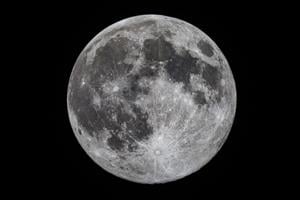Science
Asteroid Enters Earth’s Orbit, Sparking Moon Confusion

A significant discovery has emerged as an asteroid has entered Earth’s orbit, raising questions about its potential classification as a second moon. While some scientists are observing the asteroid’s behavior, which resembles that of the moon, it is essential to clarify its status. This asteroid, while rotating around Earth in a similar manner, does not meet the criteria to be considered an equal to our well-known moon.
The asteroid, which was first detected in early October 2023, has captured the attention of researchers and space enthusiasts alike. Its trajectory and rotational pattern around our planet are akin to those of the moon, leading to speculation about its role in our celestial neighborhood.
Understanding the Discovery
According to experts from NASA, the asteroid’s orbit is unique but does not qualify it as a second moon. The term “moon” typically refers to a natural satellite that meets specific criteria, including its size and the gravitational influence it exerts. Scientists emphasize that while the asteroid’s behavior may appear similar on the surface, it lacks the characteristics that define a true moon.
The discussions around this discovery have sparked interest within the scientific community and the public. Many are fascinated by the idea of a second moon, but experts remind us that the distinction is crucial for understanding our solar system. The asteroid is classified as a temporary satellite, which means its orbit around Earth is not stable enough to be deemed permanent.
Public Reaction and Scientific Clarification
Public interest in the asteroid’s behavior has led to widespread media coverage, with some outlets erroneously labeling it a second moon. The scientific community is actively working to correct these misconceptions by providing clear and accurate information.
Dr. Emily Johnson, an astronomer at the European Space Agency, stated, “While the asteroid’s orbit is intriguing, it is essential to maintain clarity about what constitutes a moon. Misunderstandings can lead to confusion among the public.”
The asteroid’s entry into Earth’s orbit serves as a reminder of the dynamic nature of space and our ongoing exploration efforts. As scientists continue to monitor the asteroid’s path, they aim to gather more data that could enhance our understanding of celestial bodies and their behaviors.
While the notion of a second moon is captivating, it remains crucial to approach such discoveries with scientific rigor. The asteroid’s presence in our orbit is a fascinating chapter in Earth’s ongoing relationship with the cosmos, but it does not alter the fact that Earth still has only one true moon.
As researchers continue to study this phenomenon, they hope to learn more about the origins and behaviors of asteroids, potentially informing future missions and enhancing our knowledge of the solar system.
-

 Science2 months ago
Science2 months agoInventor Achieves Breakthrough with 2 Billion FPS Laser Video
-

 Health2 months ago
Health2 months agoCommunity Unites for 7th Annual Into the Light Walk for Mental Health
-

 Top Stories2 months ago
Top Stories2 months agoCharlie Sheen’s New Romance: ‘Glowing’ with Younger Partner
-

 Entertainment2 months ago
Entertainment2 months agoDua Lipa Aces GCSE Spanish, Sparks Super Bowl Buzz with Fans
-

 Health2 months ago
Health2 months agoCurium Group, PeptiDream, and PDRadiopharma Launch Key Cancer Trial
-

 Top Stories2 months ago
Top Stories2 months agoFormer Mozilla CMO Launches AI-Driven Cannabis Cocktail Brand Fast
-

 Entertainment2 months ago
Entertainment2 months agoMother Fights to Reunite with Children After Kidnapping in New Drama
-

 World2 months ago
World2 months agoIsrael Reopens Rafah Crossing After Hostage Remains Returned
-

 Business2 months ago
Business2 months agoTyler Technologies Set to Reveal Q3 Earnings on October 22
-

 World2 months ago
World2 months agoR&B Icon D’Angelo Dies at 51, Leaving Lasting Legacy
-

 Health2 months ago
Health2 months agoNorth Carolina’s Biotech Boom: Billions in New Investments
-

 Health2 months ago
Health2 months agoYouTube Launches New Mental Health Tools for Teen Users









